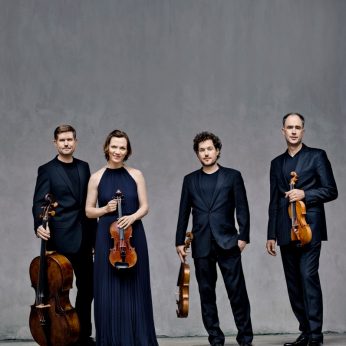Composer: Joseph Haydn (b. 1732 - d. 1809)
Performance date: 27/06/2022
Venue: St. Brendan’s Church
Duration: 00:16:56
Recording Engineer: Simon Cullen, Ergodos
Instrumentation: 2vn, va, vc
Instrumentation Category:String Quartet
Artists:
Signum Quartet (Florian Donderer, Annette Walther [violins], Xandi van Dijk [viola], Thomas Schmitz [cello]) -
[String Quartet]

Joseph Haydn [1732-1809]
String Quartet in A major Op.20/6 [1772]
1. Allegro di molto e scherzand
2. Adagio
3. Minuet – Trio – Minuet da Capo
4. Fuga con tre soggetti. Allegro
This is the shortest of the Opus 20 quartets. Nevetheless it is a considerable as well as a delightful work. Haydn did not place it last of the group. In his listing it came second after the F minor quartet (now no. 5). In the published versions of these quartets, there were as many different orderings as there were publishers. The order we have now we owe to a publisher in Amsterdam called J.J. Hummel.
Hummel also put a picture of the sun on the frontispiece, so these quartets have ever since been known as the “Sun Quartets”. We do not know why Hummel did this. It is possible that he understood that these quartets represented the dawn of the serious quartet. This seems doubtful. It was probably a simple marketing ploy, which may have worked. The Sun Quartets quickly became successful throughout Europe. They helped to establish Haydn’s international reputation.
The first movement is headed with “e scherzando” indicating that this movement will contain a good deal of humour. But Haydn is always quick to mix the humorous with serious elements and he does so here. The movement opens with a jaunty tune. In a few bars this is repeated quietly. This is followed by a sudden loud passage which leads into a long linking section to the second main idea. This is in a minor key and is based on a falling chromatic scale which introduces a cloudier moment. This is soon dispelled as more brilliant material completes the opening statement. The throbbing development is based on yet more new material which leads to a dramatic climax. This is followed by a pianissimo passage which, after a bar of silence, leads to the recapitulation.
The slow movement is a sumptuous aria for the first violin. There are two calm and beautiful main themes. The rocking accompaniment contains considerable variety; syncopation, triplets and some contrapuntal material as well. The minuet is robust and charming specially in the second half. One of the violins is dropped for the trio. The other three instruments play on only one string (una corda), and the result is sad and delicate.
The fugal finale provides a contrast to the earlier movements, which were dominated by the first violin. Here all four instruments are treated (more or less) equally. Each of the three subjects (soggetti) is short. The first opens with a typical fugal idea; three repeated notes which can be heard throughout the movement as each instrument returns to this opening theme. In the second bar the second violin introduces the second subject. After it has finished, it goes back to the first subject while the first violin is playing the third subject. If this seems complicated, it is. However, Haydn is equal to weaving an amazing tapestry of contrapuntal quartet music of increasing complexity. As a relief, the four instruments play in unison for the last six bars of the movement concluding this delightful final quartet of Opus 20.
The well-known music critic, Donald Tovey wrote: with opus 20 the historical development of Haydn’s quartets reaches its goal; and further progress is no longer progress in any historical sense but simply the difference between one masterpiece and the next… no later set of six quartets, not even Opus 76 is, on its own plane so uniformly weighty and so varied in substance as Opus 20
David Winter
Copyright © 2025 West Cork Music. All rights reserved.
Designed and developed by Matrix Internet